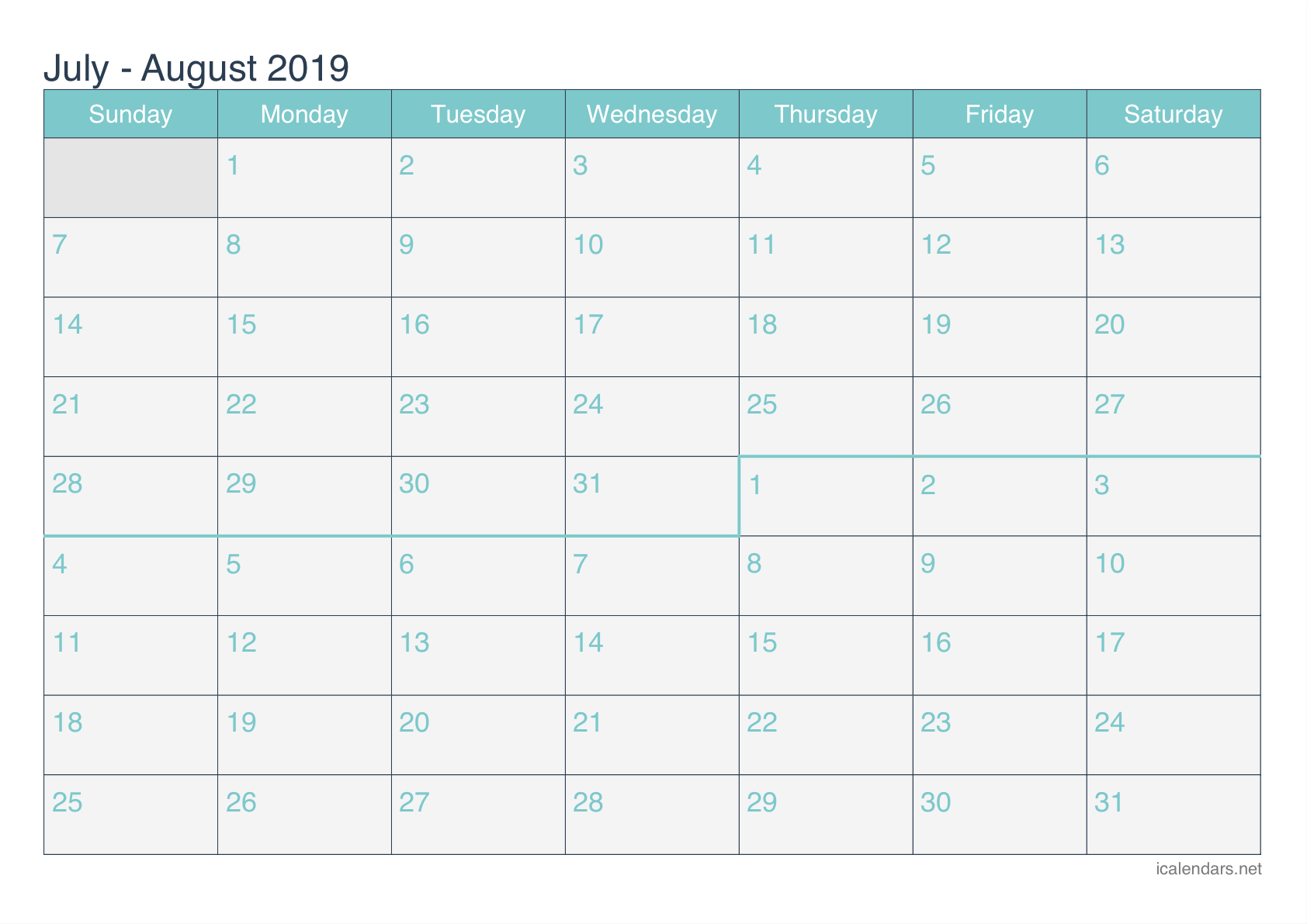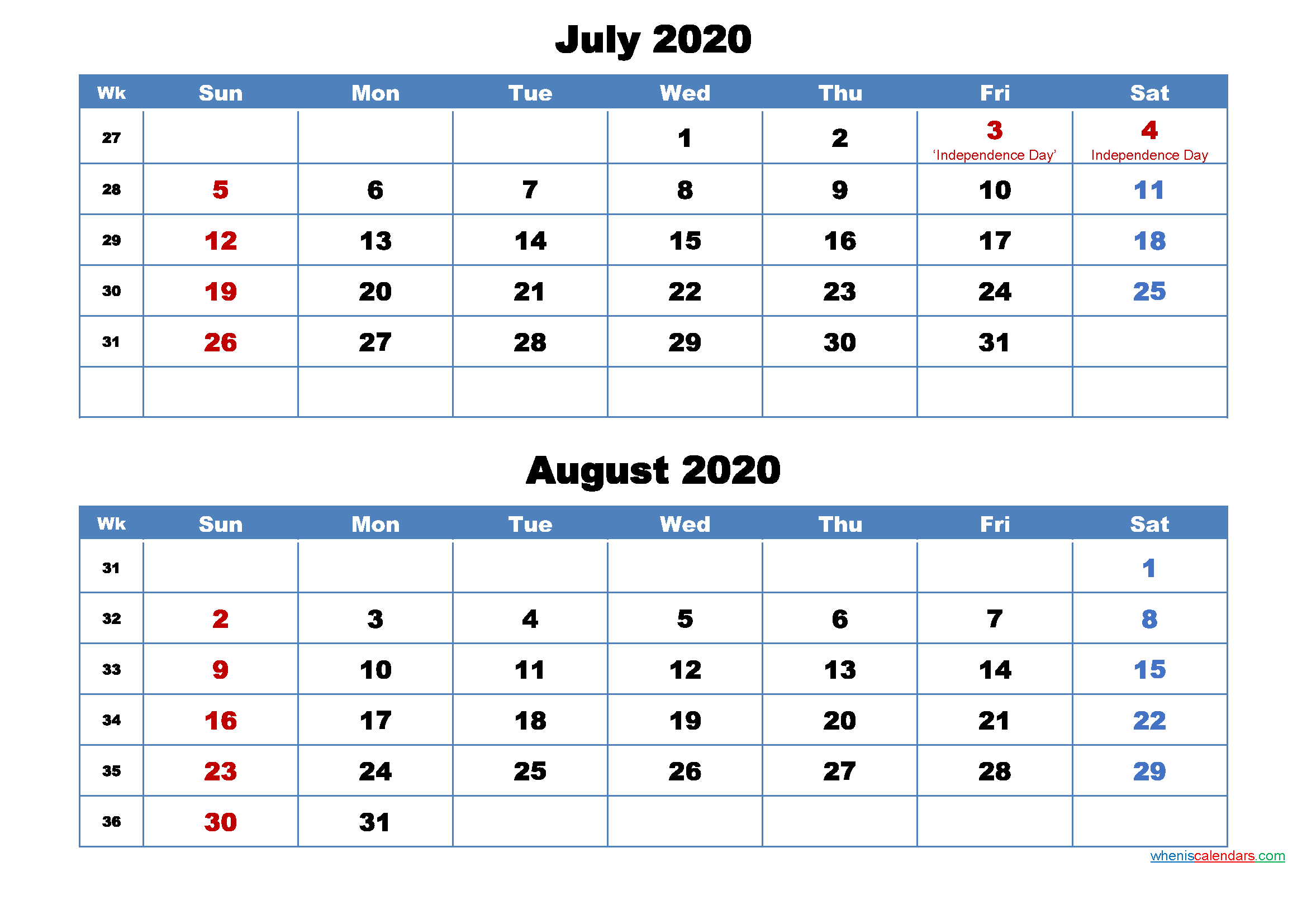The July August Calendar is your indispensable tool for staying organized and productive. From planning appointments to tracking deadlines, this comprehensive guide will empower you to harness the power of time management.
Discover the key features, customization options, and effective strategies for using a July August Calendar. Learn how to integrate it with other tools and leverage its collaborative capabilities for seamless team coordination.
July and August Calendar Overview

A July and August calendar is a visual representation of the days, weeks, and months of July and August. It helps us keep track of important dates, events, and appointments during these two months.
There are different types of July and August calendars available, including monthly calendars, weekly calendars, and daily calendars. Monthly calendars provide an overview of the entire month, while weekly calendars focus on a specific week. Daily calendars, on the other hand, provide a detailed view of each day.
Use of July and August Calendar
July and August calendars can be used in various settings, such as:
- Personal use:Keep track of personal appointments, events, and reminders.
- Business use:Schedule meetings, deadlines, and other work-related events.
- Educational use:Track school events, exams, and assignment due dates.
- Social use:Plan social gatherings, parties, and other events.
Key Features of a July and August Calendar

July and August calendars are indispensable tools for organizing and planning during the summer months. They provide a visual representation of the days, weeks, and months, helping us stay on top of appointments, events, and deadlines.
Effective July and August calendars share several essential elements:
Dates and Days of the Week, July august calendar
The most fundamental feature of a July and August calendar is the inclusion of dates and days of the week. This allows users to quickly identify specific days and plan their schedules accordingly.
Holidays
Important holidays, such as Independence Day (July 4th) and Labor Day (first Monday in September), are typically marked on July and August calendars. This helps users stay aware of upcoming holidays and plan their time off accordingly.
The July and August calendar is just around the corner, which means it’s time to start thinking about ways to make the most of the summer months. If you’re a perfume lover, you’ll want to check out the perfume advent calendar 2023 . This calendar is packed with 24 different perfumes, so you can try out a variety of scents and find your new favorites.
And, because it’s an advent calendar, you can open a new door each day leading up to Christmas. It’s a great way to celebrate the holiday season and discover new perfumes at the same time. Back to the July and August calendar, there are plenty of other fun events and activities to enjoy during the summer months, so be sure to check out your local calendar for more ideas.
Color-Coding and Visual Cues
Color-coding and other visual cues can enhance the usability of July and August calendars. Different colors can be used to represent different types of events or appointments, making it easier to differentiate between them at a glance.
The July August calendar is almost here! If you’re looking for a cute way to keep track of your appointments and events, check out our cute august 2023 calendar . It features adorable illustrations and plenty of space to write in your plans.
Plus, it’s perfect for staying organized and on top of your schedule. So don’t wait, download your free July August calendar today!
Digital vs. Physical Calendars
July and August calendars can be either digital or physical. Digital calendars offer convenience and portability, while physical calendars provide a more tangible and tactile experience. The choice between the two depends on personal preference and usage patterns.
Creating a Custom July and August Calendar

Crafting a custom July and August calendar allows you to tailor it to your specific needs and preferences. With the help of software or online tools, you can easily create a calendar that suits your style and requirements.
When selecting a template, consider the overall design and layout. Choose one that aligns with your aesthetic and provides ample space for your entries. Personalize your calendar by incorporating colors, fonts, and images that reflect your taste.
Adding Events and Reminders
Mark important events and appointments on your calendar to stay organized and on top of your schedule. Use different colors or symbols to categorize events, making it easier to visualize your commitments.
Set reminders to alert you about upcoming events or tasks. This helps ensure you don’t miss important deadlines or appointments. You can customize the reminder settings to fit your preferences, such as the time and method of notification.
Tips for Personalization
- Include notes or descriptions to provide additional context for events or appointments.
- Use stickers or images to add a touch of personality and visual interest.
- Create multiple calendars for different aspects of your life, such as work, personal, or family.
- Share your calendar with others to collaborate on events and appointments.
Using a July and August Calendar for Time Management: July August Calendar

Harnessing the power of a July and August calendar for time management empowers you to plan and track appointments, optimize task allocation, and prioritize events effectively.
Blocking Out Time for Specific Tasks
Reserve specific time slots on your July and August calendar for designated tasks. This strategy ensures that critical tasks receive dedicated attention, minimizing distractions and promoting productivity.
Prioritizing and Scheduling Events
Utilize your July and August calendar to prioritize and schedule events based on their importance and urgency. Allocate ample time for high-priority events, while accommodating lower-priority tasks within the remaining time slots.
Integrating a July and August Calendar with Other Tools

Integrating a July and August calendar with other productivity tools offers a plethora of advantages, enhancing your organizational efficiency.By syncing events and appointments across email, task management apps, and other platforms, you gain a comprehensive view of your schedule, reducing the risk of double-booking or missed appointments.
Benefits of Integration
- Seamless synchronization ensures all events and appointments are up-to-date across multiple platforms.
- Centralized scheduling eliminates the need to manually enter appointments in multiple places, saving time and reducing errors.
- Improved collaboration through shared calendars allows team members to coordinate schedules and ensure availability for meetings and events.
Commonly Asked Questions
What are the key elements of a July August Calendar?
Dates, days of the week, holidays, color-coding, and visual cues.
How can I create a custom July August Calendar?
Use software or online tools, choose a template, and personalize it with events, appointments, and reminders.
What are the benefits of using a July August Calendar for time management?
Planning and tracking appointments, blocking out time for specific tasks, and prioritizing events effectively.
